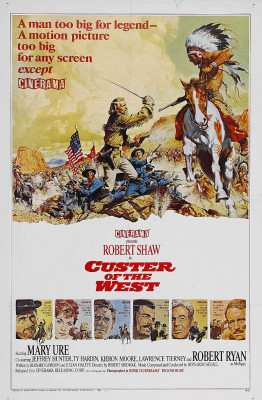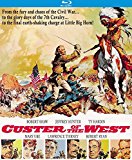| Reviews & Columns |
|
Reviews DVD TV on DVD Blu-ray 4K UHD International DVDs In Theaters Reviews by Studio Video Games Features Collector Series DVDs Easter Egg Database Interviews DVD Talk Radio Feature Articles Columns Anime Talk DVD Savant Horror DVDs The M.O.D. Squad Art House HD Talk Silent DVD
|
DVD Talk Forum |
|
|
| Resources |
|
DVD Price Search Customer Service #'s RCE Info Links |
|
Columns
|
|
|
Custer of the West
Custer's problems can all pretty much be traced back to its producer, Philip Yordan, a respected screenwriter of the 1950s who, in the early ‘60s, fell in with producer Samuel Bronston on such films as El Cid (1961), 55 Days at Peking (1963), and Fall of the Roman Empire (1964). Bronston's fall was as meteoric as his rise had been, undone by obscenely expensive, big-scale epics that eventually lost money and killed his Spain-based operations. When Bronston's career crashed and burned, Yordan's Security Pictures filled the void, producing three features for Cinerama: Custer of the West, Krakatoa East of Java (1968), and The Royal Hunt for the Sun (not presented in Super Cinerama but distributed by them, 1969).
Yordan was a colorful, somewhat shifty character. As early as 1954 he worked as a "front," taking credit for blacklisted screenwriters unable to work under their own names. During the 1960s he frequently fronted for Bernard Gordon, and he may have fronted for others whose work remains unacknowledged. Like his lower-budgeted contemporary Harry Alan Towers, Yordan continued working around the fringes of the industry until shortly before his death in 2003. While employed at MGM, I once called Yordan to inquire about several Yordan-produced titles MGM company had acquired rights to, movies so obscure even the IMDb barely knew they existed. (Ever seen Cry Wilderness, Yordan's Bigfoot epic?)
For Custer of the West, Yordan appears to have cashed in on the extensive trade coverage surrounding a Fox production long in gestation but eventually abandoned, The Day Custer Fell, which was to have been directed by Fred Zinnemann and to have featured Toshiro Mifune as either Sitting Bull or Crazy Horse. When that project was cancelled, Yordan took the public domain story of Custer and packaged his own movie, for release as a Cinerama roadshow.
Like Towers's films, Custer of the West was a tangled web of financing, an American-British-French-Spanish co-production filmed in Spain with English-Scottish leads.
Notable for its fictionalized and oddly error-ridden account, the movie opens with a montage of Custer (Robert Shaw, of From Russia with Love and Jaws) leading the charge in a series of Civil War battles. As the war ends, Gen. Sheridan (Lawrence Tierney) offers the driven, ambitious, and flamboyant taskmaster Custer the job of managing the Dakota Territory and its "Indian problem." Sheridan makes no bones that the job entails stealing land from and breaking treaties with the Lakota, Dakota, Cheyenne, and Arapaho Indians.
With loyal wife Elizabeth (Mary Ure, Shaw's actress wife) in tow, Custer takes command of the 7th Cavalry, working above alcoholic Maj. Reno (Ty Hardin) and Capt. Benteen (Jeffrey Hunter), who is more sympathetic to the plight of Native Americans than the others. Curiously, the movie makes no mention at all of Sitting Bull or Crazy Horse, possibly to avoid legal complications with Zinnemann's film, and instead makes Chief Dull Knife (Irish actor Kieron Moore), who did not participate in the Battle of the Little Bighorn, Custer's chief adversary.
Custer of the West is a mess on all fronts. The screenplay by Bernard Gordon and frequent collaborator Julian Zimet (another blacklist victim?) tries to have its cake and eat it, too, glorifying Custer's exploits while portraying him as a loyal soldier at the mercy of Washington politics and corruption, even suggesting the massacre at the Little Bighorn was the fault of an overly enthusiastic soldier's error in judgment. At the same time Custer is shown to be almost sadistic toward his men, marching them to the point where all but one of his soldiers collapses from exhaustion during a training exercise. He has no compunction about killing Indian women and children (though this is barely hinted at and the movie nearly bloodless) or stealing their land, and Custer's upwardly mobile ambitions are revealed here and there.
Mostly though, as Custer, Robert Shaw glowers steely-eyed and circumspect throughout the picture; the audience never gets inside his head. During a largely superfluous sequence, Custer meets with a deserter, Sgt. Mulligan (Robert Ryan in an extended cameo), who accuses Custer of having no soul. That seems to have been Shaw's intention, and indeed Shaw re-wrote without credit much of the scenes he's in to underscore that.
Unfortunately, Shaw-as-Custer just isn't interesting, not in the slightest. Two years later actor Richard Mulligan played Custer in Arthur Penn's Little Big Man, and though he's onscreen for maybe ten minutes of the picture's 139-minute running time (about the same as Custer of the West), Mulligan's is the far richer, infinitely more engrossing portrayal.
Custer of the West is a frustrating picture because the basic components of a very good film are there, but as if stirred with a big wooden spoon and over-boiled with no seasoning at all. Ty Hardin and Jeffrey Hunter play characters with less depth than one would find in a cheap B-Western an hour long. Robert Ryan enriches his brief part, but the character is shoehorned in to accommodate a big star cameo, not to serve the film's narrative in any significant way. Mary Ure, the only name other than Shaw's to appear in the abbreviated opening credits, has a near-nothing role as Custer's wife. In just one scene does she get to do anything much at all.
The story stops dead in tracks multiple times to provide Cinerama audiences with audience participation POV shots, riding down a lumbering flume, aboard a runaway train that crashes spectacularly. These sequences have nothing whatsoever to do with the story, but at least provide little visceral breaks from the dull dialogue sequences that never amount to anything. Robert Siodmak's direction and Bernardo Segall's lifeless musical score drag the film down even further.
Video & Audio
Currently owned by Disney, Custer of the West has had a poor home video history up to now, with DVD releases from Anchor Bay and MGM making do with inadequate 4:3 letterboxed transfers. This release of the complete 141-minute cut is still missing the overture and intermission, and the DTS-HD Master Audio is mono where the original roadshow had been six-track stereo. Nevertheless, the image is razor sharp - at least for most of the picture. At some point the film was cut to a 120-minute version, and I suspect that's all presumed to exist of the original Super Technirama negative. Miscellaneous shots and a several-minute sequence appear to have been up-rezzed from standard-definition, and scattered shots show signs of severe color flashing and other damage. Still, about 90% of Custer looks great, and a major improvement over an earlier French Blu-ray release. Region "A" encoded with optional English subtitles, this release has no Extra Features.
Parting Thoughts
Not good but worth seeing once for its fitfully fleeting Super Technirama photography, which occasionally looks great on big screens, Custer of the West is a Rent It.
Stuart Galbraith IV is the Kyoto-based film historian largely absent from reviewing these days while he restores a 200-year-old Japanese farmhouse.
|
| Popular Reviews |
| Sponsored Links |
|
|
| Sponsored Links |
|
|
| Release List | Reviews | Shop | Newsletter | Forum | DVD Giveaways | Blu-Ray | Advertise |
|
Copyright 2024 DVDTalk.com All Rights Reserved. Legal Info, Privacy Policy, Terms of Use,
Manage Preferences,
Your Privacy Choices | |||||||
















